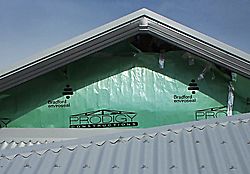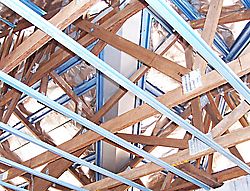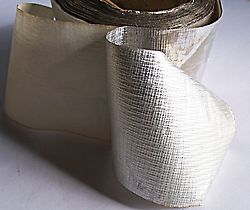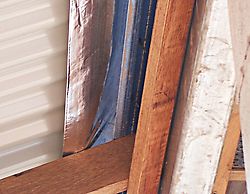 |
||||||||||||
Insulation foil, Sarking, "Sisalation", "Thermafoil", "Anticon"
We use insulation foil under the roofing iron. It's use is mandatory under the BCA. The term sarking is the correct term for any number of products that provide:-
It come in rolls 1350 (4'6") wide, and 20M and 50M long.
I have not got a shot here of roofers fixing "Sisalation" (a bit like "Biro", a generic term used by us old farts for any of the various manufacturer's products) They are so quick, and they do it early in the morning before it gets hot and more to the point, windy, but you can see from this shot from inside that it is very shiny. You can also make out that it runs parallel to the ridge or battens. The first roll starts at the bottom and the successive ones up the roof overlap the one under by minimum 150 (6inch) . The overlap distance is marked on the rolls. The top sheet will straddle the ridge and overlaps the ones under it. You can see that the valley gutter was fixed first and so the Sisalation runs into it. The sarking should sag between the purlins, to create an air gap between the roof iron and the reflective foil. The manufacturer's say a min of 20mm. This is to maintain the thermal efficiency of the material.
The joints are sealed with the manufacturer's proprietary tape and
you may think it is a bit pricey, but don't be tempted to get something
cheaper. This stuff is good gear and it is needed to last the
lifetime of the roof. Here is a shot of a part roll I have
left over from a job. The whole Idea of laying the Sisalation is to lap in in such a way as that any moisture from condensation will make its way down the roof and out at the eaves. if you go back to the first shot in this section, you can see that the Sisalation (on the vertical face of the gable) goes right down to the roof surface on the gable end. The last piece of horizontal flashing up to the gable end, will have an upturn of about 100 or so, and the Sisalation covers the flashing upturn so that any condensation running down the Sisalation finishes up outside the roof.
This is basic principal, to not let any condensation that forms on the
inside of the roof sheeting drip down inside the roof space where it
causes mildew and even stains the plasterboard ceilings. Fixing the sarking is a crap job, I don't think anyone enjoys it. A gust of wind can rip a couple of hundred dollars off your roof in seconds, but it has to be done and done right. Quite often in windy conditions or on large roofs the Sisalation is rolled out a section at a time and covered with the roof sheeting straight away. I always used medium grade (when I had the choice) Sisalation 430 or 433. I found the lighter stuff to be a lot easier to tear and rip, so harder to get right. The thicker stuff is a lot dearer, used mostly on large sheds. The foil is fixed to timber battens etc. with foil buttons, that come in strips and are belted in by a hammer. You can get double sided tape for fixing it to steel purlins, but I have never used it. A thing I have used quite a bit recently is a combination of insulation blanket sandwiched between two layers of foil. It comes in different thicknesses and with different R values. It is sometimes essential to get a design to comply with be BCA's energy efficiency requirements. Not found it yet? Try this FAST SITE SEARCH or the whole web |
Hire Equipment  Furniture Fittings - Architectural Hardware - Electronic Locking Systems - Technical Hardware BuilderBill sponsorship Other Related Pages.
BuilderBill Books Building Maths |
|||||||||||
|
some text or whatever.
|
||||||||||||
|
Please Note! The information on this site is offered as a guide only! When we are talking about areas where building regulations or safety regulations could exist,the information here could be wrong for your area. It could be out of date! Regulations breed faster than rabbits! You must check your own local conditions. Copyright © Bill Bradley 2007-2012. All rights reserved. |
||||||||||||



